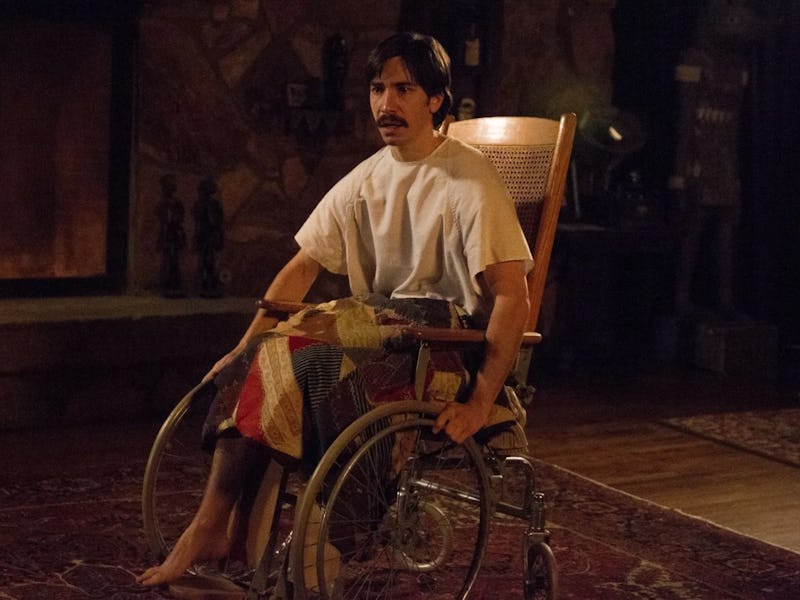They Don’t Make ‘Em Like This Anymore. That’s Probably a Good Thing.
A decade later, Kevin Smith’s freakiest movie is a relic of a bygone era.

For about 10 years, beginning in the mid-2000s, it was particularly tough to be a horror movie fan. The genre will always have its critics, but starting in 2005 with the release of Hostel, those critics were mostly right. What began with 2004’s Saw (a legitimately good thriller that launched an unwatchable franchise) quickly transformed into the very lucrative and mostly terrible horror subgenre that ultimately gave us Human Centipede in 2009, along with plenty of gory sequels and also-ran knockoffs.
But the genre got an unlikely hero in the form of Kevin Smith, who harnessed this tortured trend to give audiences a truly bizarre and mostly unwatchable sci-fi thriller that may have inadvertently ended the entire subgenre in the process.
That movie, of course, is Tusk, the bizarre story of a man who gets kidnapped and surgically transformed into a walrus. Released on September 19, 2014, the film marks its 10th anniversary today. Here’s why it’s worth celebrating its release — even if we don’t recommend watching it.
Poster art for Tusk.
Tusk stars Justin Long as Wallace, an insufferable podcaster who makes a living interviewing (read: exploiting) other people. At the start of the movie, he travels to Canada to record an episode with a boy who went viral for accidentally cutting off his own leg in an online video. But when that doesn’t work out, Wallace decides to find a new subject rather than waste the trip. The answer comes in the form of a mysterious flyer offering free lodging and the promise of some... interesting stories.
It seems too good to be true. And it is. Soon after Wallace arrives at the home of Howard Howe (Hollywood legend Michael Parks), he’s drugged and knocked unconscious. When Wallace wakes up, his leg is amputated, allegedly to save his life from a poisonous spider bite. But before too long, Howard reveals his plan to turn Wallace into a walrus through additional surgery.
Johnny Depp also has a minor role in Tusk, which Kevin Smith originally offered to Quentin Tarantino.
As the horrific operations continue, Howard reveals his own disturbing backstory (something about growing up in an orphanage, it doesn’t really matter). He removes Wallace’s tongue and fuses his armpits and elbows. He also gives him tusks sculpted out of his own amputated shinbones. With the surgery complete, Howard trains Wallace to behave like a walrus, which backfires when he impales his creator with his tusks.
Ultimately, Howard winds up dead, while Wallace is rescued. In a final scene set one year later, he’s living his best walrus life at an animal sanctuary, but a final shot hints there may still be some humanity buried beneath his rubbery skin.
Parks and Long near the end of Tusk.
While Smith was almost certainly influenced by the torture-heavy horror movies that preceded Tusk, the film’s origin can be traced back to an actual online ad that offered free housing for anyone willing to dress like a walrus. Smith saw the posting and discussed it at length in an episode of his podcast, essentially coming up with the entire movie in about an hour. Smith then polled his Twitter followers on whether he should make Tusk, and they unsurprisingly voted yes. (It was later revealed that the original online ad was a prank, but by then, there was no stopping Tusk.)
Speaking to Den of Geek in 2014, Smith also credited the classic horror movies of his childhood as the inspiration for Tusk. “Movies are about escapism, and what is more escapey than a big rubber suit all over someone?” he said. “These are the movies I grew up loving and watching and just could never make until this point in my career.”
Ultimately, like a lot of Smith’s work, Tusk became yet another of his youthful dreams fulfilled.
“I wanted to be in prosthetics when I was a kid,” he said. “So years later, with enough ability, I’m like, ‘All right, maybe I’ll make one of those movies that like I grew up loving, man.’ Like the movies that I watched on cable in the ‘80s.”
Kevin Smith and Justin Long at the premiere of Tusk.
Tusk is a lot of things. It’s a tribute to classic Hollywood horror. It’s a product of its unfortunate time. It’s a messed-up movie you can trick your friends into watching. One thing it’s not, however, is a franchise.
Unlike the 2000s thrillers that inspired it, Tusk never became a long-running series. Smith did make a spiritual sequel of sorts with Yoga Hosers, which takes place in the same cinematic universe but barely resembles the original. Plans to complete a “True North” trilogy seem to be dead in the frigid Canadian water.
And it’s not just the Tusk franchise that fell off. The entire cinematic movement launched by Saw started to run out of steam by the middle of the 2010s. The final Human Centipede movie premiered a year later in 2015, but nobody seemed to care. Saw pumped out seven annual installments before petering out in the 2010s.
Was Kevin Smith’s thriller the, ahem, tusk in the coffin that finally put an end to this grizzly trend? That may be overstating things, but I’m happy to give the director of Clerks and Dogma credit for snuffing out one of the worst subgenres in horror history.